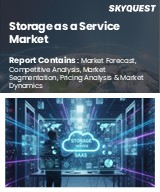
|
시장보고서
상품코드
1559705
세계의 에너지 클라우드 시장Energy Cloud |
||||||
에너지 클라우드 세계 시장은 2030년까지 629억 달러에 이를 것으로 예상
2023년에 177억 달러로 추정되는 에너지 클라우드 세계 시장은 2023년부터 2030년까지 연평균 복합 성장률(CAGR) 19.9%로 성장하며 2030년에는 629억 달러에 이를 것으로 예측됩니다. 이 보고서에서 분석한 부문 중 하나인 대기업용 에너지 클라우드는 CAGR 18.6%로 성장을 지속하고, 분석 기간이 끝날 때 402억 달러에 달할 것으로 예측됩니다. 중소기업용 에너지 클라우드 부문의 성장률은 분석 기간 동안 CAGR 22.4%로 추정됩니다.
미국 시장은 47억 달러, 중국은 CAGR 18.6%로 성장할 것으로 예측
미국의 에너지 클라우드 시장은 2023년 47억 달러로 추정됩니다. 세계 2위 경제대국인 중국은 2030년까지 94억 달러 규모에 이를 것으로 예측되며, 분석 기간 2023-2030년의 CAGR은 18.6%입니다. 다른 주목할만한 지역별 시장으로는 일본과 캐나다가 있으며, 분석 기간 중 CAGR은 각각 17.8%와 17.1%로 예측되고 있습니다. 유럽에서는 독일이 CAGR 약 14.4%로 성장할 것으로 예측됩니다.
세계 에너지 클라우드 시장 - 주요 동향과 촉진요인 요약
에너지 클라우드는 전력 산업과 에너지 관리에 어떤 혁명을 일으키고 있는가?
에너지 클라우드는 디지털 기술과 분산 에너지 자원의 통합을 통해 에너지 생성, 분배 및 소비 방법을 변화시킴으로써 전력 산업과 에너지 관리에 혁명을 일으키고 있습니다. 에너지 클라우드 개념은 전통적인 중앙 집권 에너지 시스템에서 보다 역동적이고 유연하며 효율적인 모델로 전환하는 것을 의미합니다. 이 분산 방식은 실시간 데이터 수집, 분석 및 자동 제어를 가능하게 하는 고급 디지털 플랫폼에 의해 지원되며 에너지 흐름 관리, 그리드 신뢰성 향상, 에너지 사용 최적화 가능합니다. 에너지 클라우드 시스템은 또한 프로슈머(옥상 태양광 패널 및 기타 분산형 에너지 자원(DER)을 통해 에너지를 생산하는 소비자)의 성장을 가속하고 피어 투 피어의 에너지 거래를 촉진하고 있습니다. 보다 강력하고 지속 가능한 고객 중심의 에너지·에코시스템을 실현함으로써, 에너지 클라우드는 에너지의 관리·소비 방법을 근본적으로 바꾸고, 보다 스마트하고 깨끗한 에너지의 미래에 대한 길을 열어줍니다.
에너지 클라우드의 기능성을 높이는 혁신이란?
에너지 클라우드의 혁신은 스마트 그리드 기술, 인공지능(AI), 블록체인의 발전을 통해 그 기능을 강화하고 있습니다. 가장 중요한 발전 중 하나는 전력 회사와 소비자 간의 전력 및 데이터 양방향 흐름을 가능하게 하는 스마트 그리드 인프라의 통합입니다. 스마트 그리드는 배전의 효율적인 관리를 지원하여 실시간 모니터링 및 수급 균형을 가능하게 합니다. 이는 간헐적이고 안정성을 유지하기 위해 보다 정교한 송전망 관리를 필요로 하는 신재생에너지의 비율을 높이는데 있어 매우 중요합니다. 또 다른 중요한 기술 혁신은 AI와 머신러닝의 에너지 관리에 대한 응용입니다. 이러한 기술은 에너지 수요를 예측하고 분산형 에너지 자원의 운영을 최적화하며 에너지 거래와 소비 결정을 자동화하는 예측 분석을 가능하게 합니다. 예를 들어, AI는 에너지 가격이 가장 저렴할 때나 재생 가능 에너지 발전이 피크를 맞는 시기를 예측할 수 있으며, 소비자와 기업은 그에 따라 사용량을 조정할 수 있습니다.
블록체인 기술은 또한 안전하고 투명한 분산형 에너지 거래를 가능하게 함으로써 에너지 클라우드에서 혁신적인 역할을 하고 있습니다. 블록체인은 피어 투 피어의 에너지 거래 플랫폼을 구축할 수 있으며, 프로슈머가 잉여 에너지를 다른 소비자에게 직접 판매할 수 있기 때문에 기존 전력 회사를 우회하여 새로운 경제 기회를 창출할 수 있습니다. 수 있습니다. 또한 블록체인은 신재생에너지의 원산지를 검증하고 추적하는 데 사용될 수 있어 소비자와 기업이 지속가능성 목표를 달성하고 있음을 보장합니다. 이러한 혁신의 통합으로 에너지 클라우드는 더욱 유연하고 효율적이며 탄력적이 되어 지속가능하고 분산형 에너지 시스템으로의 전환을 추진하고 있습니다.
에너지 클라우드는 에너지 효율과 지속가능성에 어떤 영향을 미치는가?
에너지 클라우드는 에너지 생성, 분배 및 소비를 최적화함으로써 에너지 효율과 지속가능성에 큰 영향을 미치고 폐기물 감소와 탄소 실적 감소를 초래합니다. 에너지 클라우드가 에너지 효율을 높이는 주요 방법 중 하나는 더 나은 수요 반응과 부하 분산을 가능하게 하는 것입니다. 실시간 데이터와 고급 분석을 통해 에너지 공급자는 수요 및 공급을 더 잘 일치시킬 수 있으며 효율성이 떨어지고 오염이 많은 피크시 발전소의 필요성을 줄일 수 있습니다. 이는 에너지 시스템 전체의 효율을 향상시킬 뿐만 아니라 재생가능 에너지 발전을 더욱 효과적으로 통합하는 데에도 도움이 됩니다. 풍력발전이나 태양광발전 등의 발전량의 변동에 대응하기 위해서 이러한 시스템을 동적으로 관리할 수 있기 때문입니다.
에너지 클라우드는 또한 깨끗한 신재생에너지 이용을 촉진함으로써 지속가능성을 지원합니다. 에너지 클라우드는 옥상 태양열 패널, 소형 풍력 터빈, 에너지 저장 시스템 등의 분산 에너지 자원을 통합할 수 있어 화석 연료에 대한 의존도를 줄이고 저탄소 에너지 시스템으로의 전환을 가속화합니다. 에너지 클라우드의 분산형 특성으로 인해 에너지를 소비지 근처에서 발전할 수 있어 송전 손실을 최소화하고 효율을 더욱 향상시킬 수 있습니다. 또한 에너지 클라우드에 블록체인 기술을 사용함으로써 에너지 조달의 투명성이 확보되고 소비자와 기업은 에너지가 재생 가능 에너지원으로부터 공급되고 있음을 확인할 수 있으므로 보다 지속 가능한 소비 패턴이 촉진됩니다.
또한 에너지 클라우드는 소비자의 에너지 시장 진입을 가능하게 하고 소비자를 에너지 생성과 관리의 적극적인 참가자로 바꿉니다. 소비자가 스스로 에너지를 생산, 저장, 거래할 수 있도록 함으로써 에너지 클라우드는 보다 지속 가능하고 강인한 에너지·에코시스템을 촉진합니다. 보다 분산적이고 고객 중심의 에너지 모델로의 전환은 세계의 지속가능성 목표를 달성하고 에너지 소비가 환경에 미치는 영향을 줄이는 핵심입니다.
에너지 클라우드 시장의 성장을 가속하는 동향은?
에너지 클라우드 시장의 성장을 이끌고 있는 동향으로는 신재생에너지 도입 확대, 에너지 분야에서의 디지털화의 대두, 분산형 에너지 시스템의 중시의 고조 등이 있습니다. 세계 정부와 기업이 이산화탄소 배출량 감축과 전력믹스에서 재생가능에너지 비율 증가에 임하고 있는 가운데 태양광이나 풍력 등의 재생가능에너지의 변동이나 분산에 대응할 수 있는 첨단 에너지 관리 시스템으로의 요구가 높아지고 있습니다. 에너지 클라우드는 이러한 전원을 효율적으로 그리드에 통합하는 데 필요한 인프라를 제공하며 지속 가능한 에너지를 미래로 전환하는 데 필수적인 요소가 되었습니다.
디지털화의 시작은 에너지 클라우드 시장의 중요한 촉진요인입니다. 에너지 부문이 사물인터넷(IoT), AI, 블록체인 등 디지털 기술을 채택함에 따라, 에너지 흐름을 실시간으로 모니터링, 분석, 제어하는 능력이 크게 향상되고 있습니다. 이 디지털 변혁은 예지 보전, 자동 수요 반응, 피어 투 피어의 에너지 거래 등 보다 정교한 에너지 관리 전략을 가능하게 하며, 모두 에너지 클라우드에 의해 촉진됩니다.
또한 분산형 에너지 시스템이 중시되고 에너지 클라우드를 채택하는 데 박차가 가해지고 있습니다. 소비자와 기업이 옥상 태양열 패널 및 가정용 축전 시스템과 같은 분산 에너지 자원에 대한 투자를 늘리면서 이러한 자원을 관리할 수 있는 유연하고 확장 가능한 플랫폼이 필수적입니다. 에너지 클라우드는 이러한 분산 자산을 보다 광범위한 에너지 시스템에 원활하게 통합할 수 있어 보다 탄력적이고 효율적인 에너지 네트워크를 제공합니다.
마지막으로 스마트 그리드, 재생 가능 에너지 통합, 에너지 효율화에 대한 규제·정책 지원도 시장 성장의 원동력이 되고 있습니다. 세계 정부가 스마트 에너지 솔루션의 도입을 장려하는 정책을 실시하고 있으며, 에너지 클라우드 기술의 배치가 가속화되고 있습니다. 이러한 추세는 보다 지속가능하고 분산되고 디지털화된 에너지 상황으로의 세계 변화를 지원하는 에너지 클라우드가 에너지 관리의 미래를 형성하는 데 중요한 역할을 한다는 것을 부각합니다. 하고 있습니다.
조사 대상 기업 예(전 11건)
- Accenture Plc
- Arcadian Projects Inc.
- Atende
- AtSite
- Conectric Networks
- Disa Corporacion Petrolifera, SA
- Dungeon Innovations
- ENECHANGE Ltd.
- Energy Cloud Technology
- enkumo
목차
제1장 조사 방법
제2장 주요 요약
- 시장 개요
- 주요 기업
- 시장 동향과 촉진요인
- 세계 시장 전망
제3장 시장 분석
- 미국
- 캐나다
- 일본
- 중국
- 유럽
- 프랑스
- 독일
- 이탈리아
- 영국
- 기타 유럽
- 아시아태평양
- 기타 지역
제4장 경쟁
JHS 24.09.27Global Energy Cloud Market to Reach US$62.9 Billion by 2030
The global market for Energy Cloud estimated at US$17.7 Billion in the year 2023, is expected to reach US$62.9 Billion by 2030, growing at a CAGR of 19.9% over the analysis period 2023-2030. Energy Cloud for Large Enterprises, one of the segments analyzed in the report, is expected to record a 18.6% CAGR and reach US$40.2 Billion by the end of the analysis period. Growth in the Energy Cloud for SMEs segment is estimated at 22.4% CAGR over the analysis period.
The U.S. Market is Estimated at US$4.7 Billion While China is Forecast to Grow at 18.6% CAGR
The Energy Cloud market in the U.S. is estimated at US$4.7 Billion in the year 2023. China, the world's second largest economy, is forecast to reach a projected market size of US$9.4 Billion by the year 2030 trailing a CAGR of 18.6% over the analysis period 2023-2030. Among the other noteworthy geographic markets are Japan and Canada, each forecast to grow at a CAGR of 17.8% and 17.1% respectively over the analysis period. Within Europe, Germany is forecast to grow at approximately 14.4% CAGR.
Global Energy Cloud Market - Key Trends and Drivers Summarized
How Is Energy Cloud Revolutionizing the Power Industry and Energy Management?
Energy Cloud is revolutionizing the power industry and energy management by transforming how energy is generated, distributed, and consumed through the integration of digital technologies and decentralized energy resources. The Energy Cloud concept refers to a shift from traditional, centralized energy systems to a more dynamic, flexible, and efficient model, where energy is produced closer to where it is used, often through renewable sources like solar and wind. This decentralized approach is supported by advanced digital platforms that allow for real-time data collection, analytics, and automated control, enabling better management of energy flows, improved grid reliability, and optimized energy usage. Energy Cloud systems are also fostering the growth of prosumers—consumers who also produce energy, typically through rooftop solar panels or other distributed energy resources (DERs)—and facilitating peer-to-peer energy trading. By enabling a more resilient, sustainable, and customer-centric energy ecosystem, the Energy Cloud is fundamentally changing the way energy is managed and consumed, paving the way for a smarter, cleaner energy future.
What Innovations Are Enhancing the Functionality of the Energy Cloud?
Innovations in the Energy Cloud are enhancing its functionality through advancements in smart grid technology, artificial intelligence (AI), and blockchain. One of the most significant developments is the integration of smart grid infrastructure, which enables the two-way flow of electricity and data between utilities and consumers. Smart grids support the efficient management of electricity distribution, allowing for real-time monitoring and balancing of supply and demand. This is crucial for integrating a higher share of renewable energy sources, which can be intermittent and require more sophisticated grid management to maintain stability. Another key innovation is the application of AI and machine learning to energy management. These technologies enable predictive analytics, which can forecast energy demand, optimize the operation of distributed energy resources, and automate energy trading and consumption decisions. For example, AI can predict when energy prices will be lowest or when renewable energy generation will peak, allowing consumers and businesses to adjust their usage accordingly.
Blockchain technology is also playing a transformative role in the Energy Cloud by enabling secure, transparent, and decentralized energy transactions. Blockchain allows for the creation of peer-to-peer energy trading platforms where prosumers can sell excess energy directly to other consumers, bypassing traditional utilities and creating new economic opportunities. Additionally, blockchain can be used to verify and track the origin of renewable energy, ensuring that consumers and businesses are meeting their sustainability goals. The integration of these innovations is making the Energy Cloud more flexible, efficient, and resilient, driving the transition to a more sustainable and decentralized energy system.
How Does the Energy Cloud Impact Energy Efficiency and Sustainability?
The Energy Cloud has a profound impact on energy efficiency and sustainability by optimizing the generation, distribution, and consumption of energy, leading to reduced waste and a lower carbon footprint. One of the primary ways the Energy Cloud enhances energy efficiency is by enabling better demand response and load balancing. Through real-time data and advanced analytics, energy providers can better match supply with demand, reducing the need for peaking power plants, which are often less efficient and more polluting. This not only improves the overall efficiency of the energy system but also helps to integrate renewable energy sources more effectively, as these systems can be dynamically managed to respond to fluctuations in generation from sources like wind and solar.
The Energy Cloud also supports sustainability by promoting the use of clean, renewable energy. With the ability to integrate distributed energy resources such as rooftop solar panels, small-scale wind turbines, and energy storage systems, the Energy Cloud reduces reliance on fossil fuels and accelerates the transition to a low-carbon energy system. The decentralized nature of the Energy Cloud allows for energy to be generated closer to where it is consumed, minimizing transmission losses and further improving efficiency. Additionally, the use of blockchain technology within the Energy Cloud ensures transparency in energy sourcing, allowing consumers and businesses to verify that their energy comes from renewable sources, thus promoting more sustainable consumption patterns.
Moreover, the Energy Cloud enables greater participation from consumers in the energy market, turning them into active participants in energy generation and management. By empowering consumers to produce, store, and trade their own energy, the Energy Cloud fosters a more sustainable and resilient energy ecosystem. This shift towards a more distributed and customer-centric energy model is key to achieving global sustainability goals and reducing the environmental impact of energy consumption.
What Trends Are Driving Growth in the Energy Cloud Market?
Several trends are driving growth in the Energy Cloud market, including the increasing deployment of renewable energy, the rise of digitalization in the energy sector, and the growing emphasis on decentralized energy systems. As governments and businesses around the world commit to reducing carbon emissions and increasing the share of renewable energy in the power mix, there is a growing need for advanced energy management systems that can handle the variability and distribution of renewable sources like solar and wind. The Energy Cloud provides the infrastructure needed to integrate these sources efficiently into the grid, making it a critical component of the transition to a sustainable energy future.
The rise of digitalization is another significant driver of the Energy Cloud market. As the energy sector adopts more digital technologies, such as the Internet of Things (IoT), AI, and blockchain, the ability to monitor, analyze, and control energy flows in real-time is vastly improved. This digital transformation is enabling more sophisticated energy management strategies, such as predictive maintenance, automated demand response, and peer-to-peer energy trading, all of which are facilitated by the Energy Cloud.
Additionally, the growing emphasis on decentralized energy systems is fueling the adoption of the Energy Cloud. As consumers and businesses increasingly invest in distributed energy resources, such as rooftop solar panels and home battery storage systems, the need for a flexible, scalable platform that can manage these resources becomes essential. The Energy Cloud allows for the seamless integration of these decentralized assets into the broader energy system, enabling more resilient and efficient energy networks.
Finally, regulatory and policy support for smart grids, renewable energy integration, and energy efficiency is also driving market growth. Governments around the world are implementing policies that encourage the adoption of smart energy solutions, which is accelerating the deployment of Energy Cloud technologies. These trends highlight the critical role of the Energy Cloud in shaping the future of energy management, as it supports the global shift towards a more sustainable, decentralized, and digitalized energy landscape.
Select Competitors (Total 11 Featured) -
- Accenture Plc
- Arcadian Projects Inc.
- Atende
- AtSite
- Conectric Networks
- Disa Corporacion Petrolifera, S.A.
- Dungeon Innovations
- ENECHANGE Ltd.
- Energy Cloud Technology
- enkumo
TABLE OF CONTENTS
I. METHODOLOGY
II. EXECUTIVE SUMMARY
- 1. MARKET OVERVIEW
- Influencer Market Insights
- Energy Cloud - Global Key Competitors Percentage Market Share in 2024 (E)
- Competitive Market Presence - Strong/Active/Niche/Trivial for Players Worldwide in 2024 (E)
- Global Economic Update
- 2. FOCUS ON SELECT PLAYERS
- 3. MARKET TRENDS & DRIVERS
- Advancements in Cloud Computing Facilitating Energy Management Solutions
- Growing Demand for Real-Time Energy Analytics and Monitoring
- Challenges in Cybersecurity for Cloud-Based Energy Systems
- Development of Virtual Power Plants (VPPs) and Their Market Impact
- Technological Innovations in Energy Efficiency and Carbon Footprint Reduction
- Future Directions: AI Integration for Predictive Energy Management
- 4. GLOBAL MARKET PERSPECTIVE
- TABLE 1: World Recent Past, Current & Future Analysis for Public Cloud by Geographic Region - USA, Canada, Japan, China, Europe, Asia-Pacific and Rest of World Markets - Independent Analysis of Annual Sales in US$ Million for Years 2023 through 2030 and % CAGR
- TABLE 2: World 7-Year Perspective for Public Cloud by Geographic Region - Percentage Breakdown of Value Sales for USA, Canada, Japan, China, Europe, Asia-Pacific and Rest of World for Years 2024 & 2030
- TABLE 3: World Recent Past, Current & Future Analysis for Hybrid Cloud by Geographic Region - USA, Canada, Japan, China, Europe, Asia-Pacific and Rest of World Markets - Independent Analysis of Annual Sales in US$ Million for Years 2023 through 2030 and % CAGR
- TABLE 4: World 7-Year Perspective for Hybrid Cloud by Geographic Region - Percentage Breakdown of Value Sales for USA, Canada, Japan, China, Europe, Asia-Pacific and Rest of World for Years 2024 & 2030
- TABLE 5: World Recent Past, Current & Future Analysis for Private Cloud by Geographic Region - USA, Canada, Japan, China, Europe, Asia-Pacific and Rest of World Markets - Independent Analysis of Annual Sales in US$ Million for Years 2023 through 2030 and % CAGR
- TABLE 6: World 7-Year Perspective for Private Cloud by Geographic Region - Percentage Breakdown of Value Sales for USA, Canada, Japan, China, Europe, Asia-Pacific and Rest of World for Years 2024 & 2030
- TABLE 7: World Recent Past, Current & Future Analysis for Large Enterprises by Geographic Region - USA, Canada, Japan, China, Europe, Asia-Pacific and Rest of World Markets - Independent Analysis of Annual Sales in US$ Million for Years 2023 through 2030 and % CAGR
- TABLE 8: World 7-Year Perspective for Large Enterprises by Geographic Region - Percentage Breakdown of Value Sales for USA, Canada, Japan, China, Europe, Asia-Pacific and Rest of World for Years 2024 & 2030
- TABLE 9: World Recent Past, Current & Future Analysis for SMEs by Geographic Region - USA, Canada, Japan, China, Europe, Asia-Pacific and Rest of World Markets - Independent Analysis of Annual Sales in US$ Million for Years 2023 through 2030 and % CAGR
- TABLE 10: World 7-Year Perspective for SMEs by Geographic Region - Percentage Breakdown of Value Sales for USA, Canada, Japan, China, Europe, Asia-Pacific and Rest of World for Years 2024 & 2030
- TABLE 11: World Energy Cloud Market Analysis of Annual Sales in US$ Million for Years 2014 through 2030
- TABLE 12: World Recent Past, Current & Future Analysis for Energy Cloud by Geographic Region - USA, Canada, Japan, China, Europe, Asia-Pacific and Rest of World Markets - Independent Analysis of Annual Sales in US$ Million for Years 2023 through 2030 and % CAGR
- TABLE 13: World 7-Year Perspective for Energy Cloud by Geographic Region - Percentage Breakdown of Value Sales for USA, Canada, Japan, China, Europe, Asia-Pacific and Rest of World Markets for Years 2024 & 2030
III. MARKET ANALYSIS
- UNITED STATES
- Energy Cloud Market Presence - Strong/Active/Niche/Trivial - Key Competitors in the United States for 2024 (E)
- TABLE 14: USA Recent Past, Current & Future Analysis for Energy Cloud by Deployment - Public Cloud, Hybrid Cloud and Private Cloud - Independent Analysis of Annual Sales in US$ Million for the Years 2023 through 2030 and % CAGR
- TABLE 15: USA 7-Year Perspective for Energy Cloud by Deployment - Percentage Breakdown of Value Sales for Public Cloud, Hybrid Cloud and Private Cloud for the Years 2024 & 2030
- TABLE 16: USA Recent Past, Current & Future Analysis for Energy Cloud by Organization Size - Large Enterprises and SMEs - Independent Analysis of Annual Sales in US$ Million for the Years 2023 through 2030 and % CAGR
- TABLE 17: USA 7-Year Perspective for Energy Cloud by Organization Size - Percentage Breakdown of Value Sales for Large Enterprises and SMEs for the Years 2024 & 2030
- CANADA
- TABLE 18: Canada Recent Past, Current & Future Analysis for Energy Cloud by Deployment - Public Cloud, Hybrid Cloud and Private Cloud - Independent Analysis of Annual Sales in US$ Million for the Years 2023 through 2030 and % CAGR
- TABLE 19: Canada 7-Year Perspective for Energy Cloud by Deployment - Percentage Breakdown of Value Sales for Public Cloud, Hybrid Cloud and Private Cloud for the Years 2024 & 2030
- TABLE 20: Canada Recent Past, Current & Future Analysis for Energy Cloud by Organization Size - Large Enterprises and SMEs - Independent Analysis of Annual Sales in US$ Million for the Years 2023 through 2030 and % CAGR
- TABLE 21: Canada 7-Year Perspective for Energy Cloud by Organization Size - Percentage Breakdown of Value Sales for Large Enterprises and SMEs for the Years 2024 & 2030
- JAPAN
- Energy Cloud Market Presence - Strong/Active/Niche/Trivial - Key Competitors in Japan for 2024 (E)
- TABLE 22: Japan Recent Past, Current & Future Analysis for Energy Cloud by Deployment - Public Cloud, Hybrid Cloud and Private Cloud - Independent Analysis of Annual Sales in US$ Million for the Years 2023 through 2030 and % CAGR
- TABLE 23: Japan 7-Year Perspective for Energy Cloud by Deployment - Percentage Breakdown of Value Sales for Public Cloud, Hybrid Cloud and Private Cloud for the Years 2024 & 2030
- TABLE 24: Japan Recent Past, Current & Future Analysis for Energy Cloud by Organization Size - Large Enterprises and SMEs - Independent Analysis of Annual Sales in US$ Million for the Years 2023 through 2030 and % CAGR
- TABLE 25: Japan 7-Year Perspective for Energy Cloud by Organization Size - Percentage Breakdown of Value Sales for Large Enterprises and SMEs for the Years 2024 & 2030
- CHINA
- Energy Cloud Market Presence - Strong/Active/Niche/Trivial - Key Competitors in China for 2024 (E)
- TABLE 26: China Recent Past, Current & Future Analysis for Energy Cloud by Deployment - Public Cloud, Hybrid Cloud and Private Cloud - Independent Analysis of Annual Sales in US$ Million for the Years 2023 through 2030 and % CAGR
- TABLE 27: China 7-Year Perspective for Energy Cloud by Deployment - Percentage Breakdown of Value Sales for Public Cloud, Hybrid Cloud and Private Cloud for the Years 2024 & 2030
- TABLE 28: China Recent Past, Current & Future Analysis for Energy Cloud by Organization Size - Large Enterprises and SMEs - Independent Analysis of Annual Sales in US$ Million for the Years 2023 through 2030 and % CAGR
- TABLE 29: China 7-Year Perspective for Energy Cloud by Organization Size - Percentage Breakdown of Value Sales for Large Enterprises and SMEs for the Years 2024 & 2030
- EUROPE
- Energy Cloud Market Presence - Strong/Active/Niche/Trivial - Key Competitors in Europe for 2024 (E)
- TABLE 30: Europe Recent Past, Current & Future Analysis for Energy Cloud by Deployment - Public Cloud, Hybrid Cloud and Private Cloud - Independent Analysis of Annual Sales in US$ Million for the Years 2023 through 2030 and % CAGR
- TABLE 31: Europe 7-Year Perspective for Energy Cloud by Deployment - Percentage Breakdown of Value Sales for Public Cloud, Hybrid Cloud and Private Cloud for the Years 2024 & 2030
- TABLE 32: Europe Recent Past, Current & Future Analysis for Energy Cloud by Organization Size - Large Enterprises and SMEs - Independent Analysis of Annual Sales in US$ Million for the Years 2023 through 2030 and % CAGR
- TABLE 33: Europe 7-Year Perspective for Energy Cloud by Organization Size - Percentage Breakdown of Value Sales for Large Enterprises and SMEs for the Years 2024 & 2030
- TABLE 34: Europe Recent Past, Current & Future Analysis for Energy Cloud by Geographic Region - France, Germany, Italy, UK and Rest of Europe Markets - Independent Analysis of Annual Sales in US$ Million for Years 2023 through 2030 and % CAGR
- TABLE 35: Europe 7-Year Perspective for Energy Cloud by Geographic Region - Percentage Breakdown of Value Sales for France, Germany, Italy, UK and Rest of Europe Markets for Years 2024 & 2030
- FRANCE
- Energy Cloud Market Presence - Strong/Active/Niche/Trivial - Key Competitors in France for 2024 (E)
- TABLE 36: France Recent Past, Current & Future Analysis for Energy Cloud by Deployment - Public Cloud, Hybrid Cloud and Private Cloud - Independent Analysis of Annual Sales in US$ Million for the Years 2023 through 2030 and % CAGR
- TABLE 37: France 7-Year Perspective for Energy Cloud by Deployment - Percentage Breakdown of Value Sales for Public Cloud, Hybrid Cloud and Private Cloud for the Years 2024 & 2030
- TABLE 38: France Recent Past, Current & Future Analysis for Energy Cloud by Organization Size - Large Enterprises and SMEs - Independent Analysis of Annual Sales in US$ Million for the Years 2023 through 2030 and % CAGR
- TABLE 39: France 7-Year Perspective for Energy Cloud by Organization Size - Percentage Breakdown of Value Sales for Large Enterprises and SMEs for the Years 2024 & 2030
- GERMANY
- Energy Cloud Market Presence - Strong/Active/Niche/Trivial - Key Competitors in Germany for 2024 (E)
- TABLE 40: Germany Recent Past, Current & Future Analysis for Energy Cloud by Deployment - Public Cloud, Hybrid Cloud and Private Cloud - Independent Analysis of Annual Sales in US$ Million for the Years 2023 through 2030 and % CAGR
- TABLE 41: Germany 7-Year Perspective for Energy Cloud by Deployment - Percentage Breakdown of Value Sales for Public Cloud, Hybrid Cloud and Private Cloud for the Years 2024 & 2030
- TABLE 42: Germany Recent Past, Current & Future Analysis for Energy Cloud by Organization Size - Large Enterprises and SMEs - Independent Analysis of Annual Sales in US$ Million for the Years 2023 through 2030 and % CAGR
- TABLE 43: Germany 7-Year Perspective for Energy Cloud by Organization Size - Percentage Breakdown of Value Sales for Large Enterprises and SMEs for the Years 2024 & 2030
- ITALY
- TABLE 44: Italy Recent Past, Current & Future Analysis for Energy Cloud by Deployment - Public Cloud, Hybrid Cloud and Private Cloud - Independent Analysis of Annual Sales in US$ Million for the Years 2023 through 2030 and % CAGR
- TABLE 45: Italy 7-Year Perspective for Energy Cloud by Deployment - Percentage Breakdown of Value Sales for Public Cloud, Hybrid Cloud and Private Cloud for the Years 2024 & 2030
- TABLE 46: Italy Recent Past, Current & Future Analysis for Energy Cloud by Organization Size - Large Enterprises and SMEs - Independent Analysis of Annual Sales in US$ Million for the Years 2023 through 2030 and % CAGR
- TABLE 47: Italy 7-Year Perspective for Energy Cloud by Organization Size - Percentage Breakdown of Value Sales for Large Enterprises and SMEs for the Years 2024 & 2030
- UNITED KINGDOM
- Energy Cloud Market Presence - Strong/Active/Niche/Trivial - Key Competitors in the United Kingdom for 2024 (E)
- TABLE 48: UK Recent Past, Current & Future Analysis for Energy Cloud by Deployment - Public Cloud, Hybrid Cloud and Private Cloud - Independent Analysis of Annual Sales in US$ Million for the Years 2023 through 2030 and % CAGR
- TABLE 49: UK 7-Year Perspective for Energy Cloud by Deployment - Percentage Breakdown of Value Sales for Public Cloud, Hybrid Cloud and Private Cloud for the Years 2024 & 2030
- TABLE 50: UK Recent Past, Current & Future Analysis for Energy Cloud by Organization Size - Large Enterprises and SMEs - Independent Analysis of Annual Sales in US$ Million for the Years 2023 through 2030 and % CAGR
- TABLE 51: UK 7-Year Perspective for Energy Cloud by Organization Size - Percentage Breakdown of Value Sales for Large Enterprises and SMEs for the Years 2024 & 2030
- REST OF EUROPE
- TABLE 52: Rest of Europe Recent Past, Current & Future Analysis for Energy Cloud by Deployment - Public Cloud, Hybrid Cloud and Private Cloud - Independent Analysis of Annual Sales in US$ Million for the Years 2023 through 2030 and % CAGR
- TABLE 53: Rest of Europe 7-Year Perspective for Energy Cloud by Deployment - Percentage Breakdown of Value Sales for Public Cloud, Hybrid Cloud and Private Cloud for the Years 2024 & 2030
- TABLE 54: Rest of Europe Recent Past, Current & Future Analysis for Energy Cloud by Organization Size - Large Enterprises and SMEs - Independent Analysis of Annual Sales in US$ Million for the Years 2023 through 2030 and % CAGR
- TABLE 55: Rest of Europe 7-Year Perspective for Energy Cloud by Organization Size - Percentage Breakdown of Value Sales for Large Enterprises and SMEs for the Years 2024 & 2030
- ASIA-PACIFIC
- Energy Cloud Market Presence - Strong/Active/Niche/Trivial - Key Competitors in Asia-Pacific for 2024 (E)
- TABLE 56: Asia-Pacific Recent Past, Current & Future Analysis for Energy Cloud by Deployment - Public Cloud, Hybrid Cloud and Private Cloud - Independent Analysis of Annual Sales in US$ Million for the Years 2023 through 2030 and % CAGR
- TABLE 57: Asia-Pacific 7-Year Perspective for Energy Cloud by Deployment - Percentage Breakdown of Value Sales for Public Cloud, Hybrid Cloud and Private Cloud for the Years 2024 & 2030
- TABLE 58: Asia-Pacific Recent Past, Current & Future Analysis for Energy Cloud by Organization Size - Large Enterprises and SMEs - Independent Analysis of Annual Sales in US$ Million for the Years 2023 through 2030 and % CAGR
- TABLE 59: Asia-Pacific 7-Year Perspective for Energy Cloud by Organization Size - Percentage Breakdown of Value Sales for Large Enterprises and SMEs for the Years 2024 & 2030
- REST OF WORLD
- TABLE 60: Rest of World Recent Past, Current & Future Analysis for Energy Cloud by Deployment - Public Cloud, Hybrid Cloud and Private Cloud - Independent Analysis of Annual Sales in US$ Million for the Years 2023 through 2030 and % CAGR
- TABLE 61: Rest of World 7-Year Perspective for Energy Cloud by Deployment - Percentage Breakdown of Value Sales for Public Cloud, Hybrid Cloud and Private Cloud for the Years 2024 & 2030
- TABLE 62: Rest of World Recent Past, Current & Future Analysis for Energy Cloud by Organization Size - Large Enterprises and SMEs - Independent Analysis of Annual Sales in US$ Million for the Years 2023 through 2030 and % CAGR
- TABLE 63: Rest of World 7-Year Perspective for Energy Cloud by Organization Size - Percentage Breakdown of Value Sales for Large Enterprises and SMEs for the Years 2024 & 2030



















